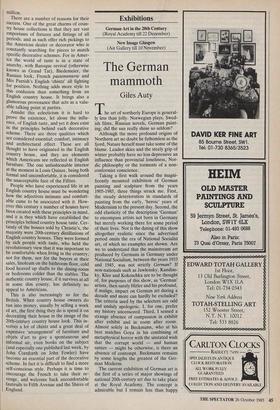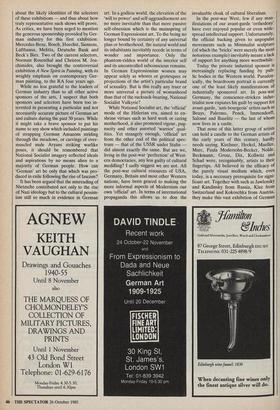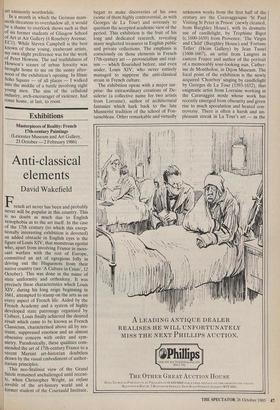Exhibitions
German Art in the 20th Century (Royal Academy till 22 December)
New Image Glasgow (Air Gallery till 10 November)
The German mammoth
Giles Auty
The art of northerly Europe is general- ly less than jolly. Norwegian plays, Swed- ish films, Russian novels, German paint- ing; did the sun really shine so seldom? Although the more profound origins of Northern art no doubt lie fathomless as the fjord, Nature herself must take some of the blame. Leaden skies and the steely grip of winter probably have no less depressive an influence than provincial loneliness, Nor- dic philosophy or the torments of a non- conformist conscience.
Taking a first walk around the magni- ficently mounted exhibition of German painting and sculpture from the years 1905-1985, three things struck me. First, the steady deterioration in standards of painting from the early, 'heroic' years of Modernism to the present day. Second, the odd elasticity of the description `German' to encompass artists not born in Germany but merely working there for some period of their lives. Nor is the dating of this show altogether realistic since the advertised period omits the era of National Socialist art, of which no examples are shown. Are we to understand that the mainstream art produced by Germans in Germany under National Socialism, between the years 1933 and 1945, was not strictly German? If non-nationals such as Jawlensky, Kandins- ky, Klee and Kokoschka are to be thought of, for purposes of this show, as `German' artists, then surely Hitler and his profound, if malign, impact on German art during a decade and more can hardly be excluded? The criteria used by the selectors are odd and unduly apologetic. I, for one, prefer my history uncensored. Third, I sensed a strange absence of compassion in exhibit after exhibit and in room after room. Almost solely in Beckmann, who at his best matches Goya in his combining of metaphysical horror with the unstated wish that the corrupt world — and human nature — might be otherwise, is there an absence of contempt. Beckmann remains by some lengths the greatest of the Ger- man Moderns.
The current exhibition of German art is the first of a series of major showings of national 20th-century art due to take place at the Royal Academy. The concept is admirable but I remain less than happy about the likely identities of the selectors of these exhibitions — and thus about how truly representative such shows will prove. As critics, we have been urged to mention the generous sponsorship provided by Ger- man industry for this first exhibition: Mercedes-Benz, Bosch, Hoechst, Siemens, Lufthansa, Melitta, Deutsche Bank and Beck's Bier. Two of the current selectors, Norman Rosenthal and Christos M. Joa- chimides, also brought the controversial exhibition A New Spirit in Painting, with its weighty emphasis on contemporary Ger- man painting, to the RA four years ago.
While no less grateful to the leaders of German industry than to all other active sponsors of the arts, I suspect that both sponsors and selectors have been too in- terested in presenting a particular and not necessarily accurate picture of German art and culture during the past 50 years. While it might take a brave sponsor to put his name to any show which included paintings of strapping German Amazons striding through the meadows, or carvings of over- muscled male Aryans striking warlike poses, it should be remembered that National Socialist imagery reflected ideals and aspirations by no means alien to a majority of German people. How can `German' art be only that which was pro- duced in exile following the rise of fascism?
It has been argued that the misreading of Nietzsche contributed not only to the rise of Nazi ideology but to the cultural pessim- ism still so much in evidence in German art. In a godless world, the elevation of the `will to power' and self-aggrandisement are no more inevitable than that more passive self-obsession which is the mainspring of German Expressionist art. To the being no longer bound by certainty of any universal plan or brotherhood, the natural world and its inhabitants inevitably recede in terms of wonder and importance. Only the phantom-ridden world of the interior self and its uncontrolled subconscious remains. In German Expressionism women may appear solely as whores or grotesques or projections of the artist's particular brand of sexuality. But is this really any truer or more universal a picture of womanhood than that of the rucksack-bearing, National Socialist Valkyrie?
While National Socialist art, the 'official' mode of the Hitlerian era, aimed to en- shrine virtues such as hard work or caring motherhood, it also promoted vigour, pug- nacity and other assorted `warrior' qual- ities. Yet strangely enough, 'official' art from the other end of the political spec- trum — that of the USSR under Stalin — did almost exactly the same. But are we, living in the post-war 'perfection' of West- ern democracies, any less guilty of cultural meddling? I sadly suggest we are not. All the post-war cultural resources of USA, Germany, Britain and most other Western nations, have been geared to making the more informal aspects of Modernism our own `official' art. In terms of international propaganda this allows us to don the invaluable cloak of cultural liberalism.
In the post-war West, few if any man- ifestations of our avant-garde 'orthodoxy' have ever enjoyed popular or even wide- spread intellectual support. Unfortunately, the official backing given to unpopular movements such as Minimalist sculpture (of which the 'bricks' were merely the most notorious example) inevitably meant a lack of support for anything more worthwhile.
Today the private industrial sponsor is increasingly replacing funding by pub- lic bodies in the Western world. Paradox- ically, the boardroom portrait is currently one of the least likely manifestations of industrially sponsored art. In post-war Germany, the conscience-stricken indus- trialist now expiates his guilt by support for avant-garde, 'anti-bourgeois' artists such as Beuys, Palermo, Penck, Immendorff, Salome and Baselitz — the last of whom now lives in a castle.
That none of this latter group of artists can hold a candle to the German artists of the early years of this century, hardly needs saying. Kirchner, Heckel, Mueller, Marc, Paula Modersohn-Becker, Nolde, Beckmann, Grosz, Dix, Kollwitz and Schad were, recognisably, artists to their fingertips. All believed in the efficacy of the purely visual medium which, even today, is a necessary prerequisite for signi- ficant art. Together with such as Jawlensky and Kandinsky from Russia, Klee from Switzerland and Kokoschka from Austria, they make this vast exhibition of German
art eminently worthwhile.
In a month in which the German mam- moth threatens to overshadow all, it would be a shame to overlook shows such as that of six former students of Glasgow School of Art at Air Gallery (6 Rosebery Avenue, EC1). While Steven Campbell is the best known of these young, exuberant artists, my own slight preference was for the work of Peter Howson. The sad truthfulness of Howson's scenes of urban ferocity was brought home to me on the sunny after- noon of the exhibition's opening. In filmic Soho Square — of all places — I walked into the middle of a battle involving eight young men. The sins of the celluloid industry, arch-encourager of violence, had come home, at last, to roost.




























































 Previous page
Previous page